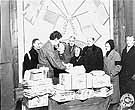
|
|
|

|

|

|

|
|
Click on an image to see a larger, more detailed picture.
|
|
|
|
|
| 1945: Liberation and Rebuilding |

|
pg. 633 |

|
|
|
|
| |
 Life was extremely precarious for Holocaust survivors after their liberation. Most had no place to live, no families left, and nothing to eat. Without a massive relief effort, many more of them would have died. Among the organizations that played an important role in aiding Holocaust survivors were the Red Cross and the American Jewish Joint Distribution Committee (JDC). This photograph, taken in Vienna, shows Harry Weinsaft, a member of the JDC, distributing Red Cross parcels to displaced Jews.
Life was extremely precarious for Holocaust survivors after their liberation. Most had no place to live, no families left, and nothing to eat. Without a massive relief effort, many more of them would have died. Among the organizations that played an important role in aiding Holocaust survivors were the Red Cross and the American Jewish Joint Distribution Committee (JDC). This photograph, taken in Vienna, shows Harry Weinsaft, a member of the JDC, distributing Red Cross parcels to displaced Jews.
Photo: National Archives/United States Holocaust Memorial Museum Photo Archive
|
 Russian men, women, and children stroll along the path of a displaced-persons camp in Allach, near Munich, Germany. Laundry hanging to dry testifies to their efforts to establish a pattern of normal life. At the end of the war, seven to nine million displaced persons were scattered throughout Europe, most of them uncertain about what the future would hold.
Russian men, women, and children stroll along the path of a displaced-persons camp in Allach, near Munich, Germany. Laundry hanging to dry testifies to their efforts to establish a pattern of normal life. At the end of the war, seven to nine million displaced persons were scattered throughout Europe, most of them uncertain about what the future would hold.
Photo: Bildarchiv Preussischer Kulturbesitz
|
 Joint Distribution Committee
Joint Distribution Committee
The American Jewish Joint Distribution Committee (JDC) was the primary vehicle for relief operations carried out by American Jewry both during and after the war. While the JDC never mounted a mass rescue operation in Europe, its efforts on behalf of European Jewry were particularly important after World War II. During the Holocaust, the JDC's relief activities increased the survival chances for many Jews. Its funds provided aid for European orphanages, hospitals, and public kitchens. Money from the JDC also helped Jews obtain false identity papers and send food parcels to those in concentration camps and ghettos. After the war, the committee intensified its efforts. Together with other organizations, the JDC provided tremendous support for Jews living in Europe's displaced-persons camps. The JDC spent $280 million from 1946 to 1950 on food, clothing, books, school supplies, and other necessities. In the photo seen here, JDC officials discuss a map of the organization's activities in the U.S. Zone of Germany. With the founding of the Israeli State, the JDC helped bring refugees to Israel and established vocational training centers. That Israel overcame early obstacles and gave Holocaust survivors opportunities to rebuild their lives was due in no small part to the focus and dedication of the JDC.
Photo: Aviva Kempner / United States Holocaust Memorial Museum Photo Archive
|
|

|

|

|

|
 October 1945: At Boleslawiec, Poland, eight Jews are murdered by an antisemitic Polish underground group.
October 1945: At Boleslawiec, Poland, eight Jews are murdered by an antisemitic Polish underground group.
|
 October 1945: Pastor Martin Niemöller, German resister and founder of the Confessional Church, issues the Stuttgart Confession of Guilt, which maintains the collective guilt of the German people for the Hitler regime.
October 1945: Pastor Martin Niemöller, German resister and founder of the Confessional Church, issues the Stuttgart Confession of Guilt, which maintains the collective guilt of the German people for the Hitler regime.
|
 October 6, 1945: Important German detainees at Nuremberg are informed for the first time that they are to be the defendants in an international trial.
October 6, 1945: Important German detainees at Nuremberg are informed for the first time that they are to be the defendants in an international trial.
|
 October 9, 1945: After his trial in Paris, French collaborationist politician Pierre Laval is executed by firing squad.
October 9, 1945: After his trial in Paris, French collaborationist politician Pierre Laval is executed by firing squad.
|
 October 10, 1945: The NSDAP is abolished, some 25 years after originating in Munich, Germany.
October 10, 1945: The NSDAP is abolished, some 25 years after originating in Munich, Germany.
|
 October 24, 1945: Norwegian traitor Vidkun Quisling is executed at Oslo, Norway.
October 24, 1945: Norwegian traitor Vidkun Quisling is executed at Oslo, Norway.
|
 October 24, 1945: Nazi trade-union chief Robert Ley hangs himself in his prison cell at Nuremberg.
October 24, 1945: Nazi trade-union chief Robert Ley hangs himself in his prison cell at Nuremberg.
|
|
|
|
|
| 1945: Liberation and Rebuilding |

|
pg. 633 |

|
|
The Holocaust Chronicle
© 2009 Publications International, Ltd.
|
|
